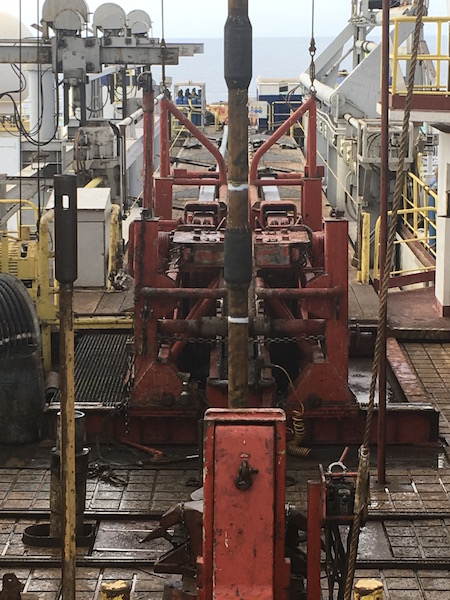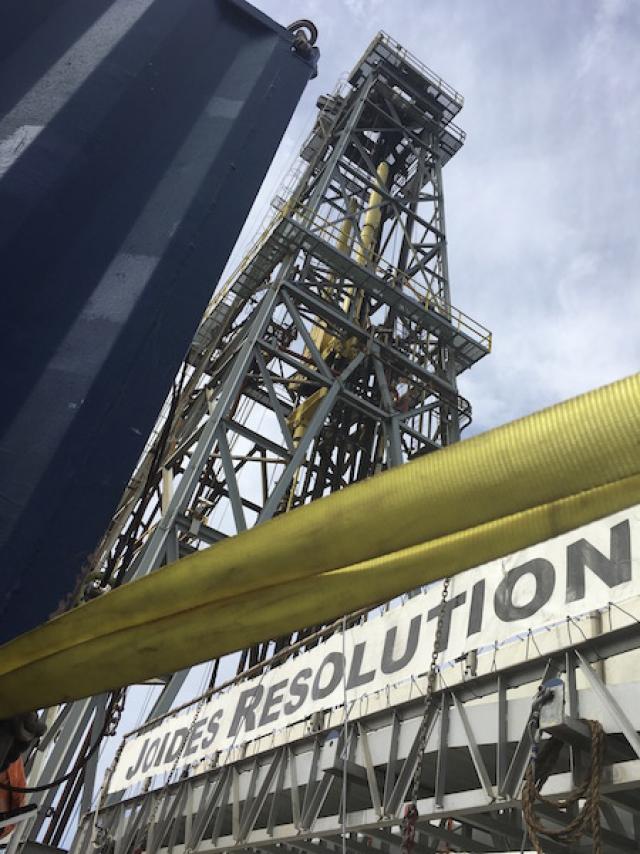
The JOIDES Resolution reaches the Sea Floor!
The JOIDES Resolution reaches the Sea Floor! How does it do that? We have 2 guest bloggers, our Expedition Project Manager Carlos and our Operations Superintendent Kevin Grigar from IODP JRSO, who have worked together to describe the ships operations when setting up for deep sea exploration!
Here is a summary of the coring apparatus that helps retrieve core samples from the bottom of the South China Sea! This is an excerpt from out daily reports from when we approached and readied up for our first drill site!
— As we approached Site U1501, we slowed down and lowered the 10 retractable thrusters. This likely woke up some Noon-Midnight shift people! Once the thrusters were down, we used PS to stabilize the ship over the drill site and tossed a seafloor positioning sonar beacon over the side, and let it fall to the seafloor – we use these in combination with GPS to position the ship.
As soon as the ship was stable enough, the rig floor got to work assembling the drill string! Once the bit is on the rig floor, the will attach a bit sub (a short piece of 8.25 inch diameter drill collar) and started picking up the drill collars (the very thick-walled, heavy, orange pipe – the one silver drill collar is non-magnetic) – this also will makes lots of noise as they pull the drill collars up from where they are stored on the main deck below the rig floor.
These heavy drill collars at the bottom of the drill string will keep it in tension, it is fairly still, and also provides weight on the bit. Each joint of drill collar is ~ 10 m long and are assembled in stands (3 joints make up 1 stand). Typically above the drill collars, we added one more drill collar and then a tapered drill collar – this makes a transition between the 8.25-inch drill collars and the 5.5-inch drill pipe, and then started adding stands of 5-inch drill pipe – we’ll keep doing that until we get close to the seafloor.
The first time we pick up the drill collars and stands of drill pipe, as Kevin Grigar, our Operations Superintendent explained, they will “strap and rabbit” the drill pipe [“strap’ = measure the length of every piece of pipe; “rabbit” = pass a tool through the interior of each piece of pipe to make sure its interior diameter is fully open]. After adding many, many stands of drill pipe…the bit will finally reach close to the seafloor, and we will swing the top drive into place (the top drive is a big electric motor that rotates the drill string, and allows us to pump fluid so that we can shoot APC cores – piston cores), attache knobbies (drill pipe with multiple places we can land the drill string on an elevator),. We’ll then space out for taking the first core. Spacing out is just adjusting the height of the bit above the seafloor, so that it is properly positions to take the mudline core. First core on deck?? Currently estimated to be between 22:00 and midnight tonight, but don’t hold your breath. It could arrive a bit earlier – OR – perhaps a while later!
Information provided by Carlos Alvarez Zarikian, Expedition Project Manager/Staff Scientist, and Kevin Grigar, Operations Superintendent, IODP JRSO
